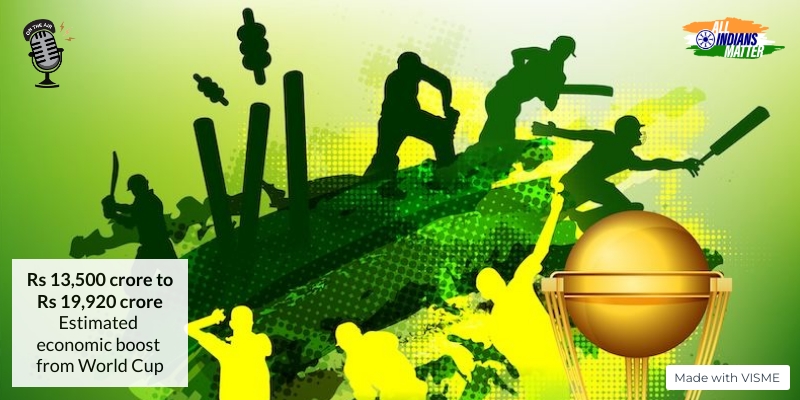Ashraf Engineer
November 25, 2023
EPISODE TRANSCRIPT
Hello and welcome to All Indians Matter. I am Ashraf Engineer.
The cricket World Cup has just ended. While it was heartbreak for India in the finals, there’s much to smile about on the economic front. While the numbers at the end of the tournament are yet to be crunched, the pre-event numbers are a good indicator of the World Cup’s impact. Economists at the Bank of Baroda calculated that it would inject $2.4 billion, or Rs 19,920 crore, into the Indian economy while a report from BQ Prime predicted an economic boost of Rs 13,500 crore. Whatever the final number turns out to be, it will be significant. After all, cricket is much more than a sport in India and its popularity is growing across the world. It is followed by an estimated 2.5 billion fans, making it the world’s second-most popular sport after football.
SIGNATURE TUNE
It is well understood that major sporting events like the football world cup or the Olympics lead to greater consumer spending, which benefits several sectors – from consumer electronics to hotels and travel. This is why the cricket World Cup was way more than just a tournament.
The 2019 edition, hosted and won by England, recorded a viewership of 552 million and became one of the most-watched sporting events in Indian television history. The India-Pakistan match alone had 244 million viewers, according to BARC data. It’s a given that the overall viewership for the 2023 World Cup would have exceeded that of 2019.
In India, especially, major cricket tournaments are treated as festivals. Hundreds of thousands of people travel to venues, book hotels, frequent restaurants and buy goods from local stores. Those not attending in person, watch the matches on television or online, consuming advertising content, food and drink. The latter are often procured through e-commerce services like Swiggy and Zomato. No surprise then that, in the run up to the World Cup, shares of food delivery company Zomato got close to a 52-week high. Jubilant Foodworks, which runs Domino’s in India, is also expected to witness a very strong quarter.
The food and beverages industry is among the top beneficiaries of such an event. Not only do consumers order food online often, many watch the matches in restaurants and pubs. These establishments experience a windfall.
Sport is a target for sponsorships and media spends, clocking an estimated $1.8 billion annually. Of this, cricketing events alone account for $900 million of media spending a year and constitute 8% of India’s total advertising spend.
Meanwhile, e-commerce is expected to report a purple patch on the back of sales of a range of goods, from televisions to cricket accessories.
E-commerce, in fact, would have benefited from the World Cup coinciding with India’s festive season – historically, the best part of the year for the Indian economy. As reported by PTI, the appliances and consumer electronics sector is likely to surpass Rs 70,000 crore in sales this year due to multiple festivals and the World Cup.
Travel, too, benefited. Demand for domestic and international flights to India surged in the months running up to the World Cup, with flight searches to India rising 110% to 130%, according to data from OTA Insight, a market intelligence platform. Travel analytics firm Cirium said there were 787 flights scheduled from November 13 to 19 to Ahmedabad, which hosted the final.
Demand for international flights to India rose 15% due to bookings from Australia, England, New Zealand, Sri Lanka and the Netherlands. Teams from all these nations played in the tournament.
I want to come back to advertising. Marketing and sporting tournaments go hand in hand. By advertising in such events, companies guarantee eyeballs and brand retention. The World Cup was a great platform for advertisers. The official broadcaster roped in large sponsors, from Hindustan Unilever to Mahindra & Mahindra.
While it’s clear how consumption would have been boosted by the World Cup, the one nagging concern was higher inflation. Hotel rooms and air tickets, for example, got costlier as the World Cup approached. Even service charges in the informal sector experienced an increase. What would be the impact on overall inflation? Analysts say it could have risen by 0.15% to 0.25% for October and November.
The cricket World Cup didn’t showcase just India’s prowess in the sport. It was, in many ways, a celebration of the economic benefits it offered. Tournaments such as these reboot consumption and we certainly saw that – at least before and during the event.
As the matches played out, it wasn’t just the scorecard but also the cash registers that were kept busy.
Thank you all for listening. Please visit allindiansmatter.in for more columns and audio podcasts. You can follow me on Twitter at @AshrafEngineer and @AllIndiansCount. Search for the All Indians Matter page on Facebook. On Instagram, the handle is @AllIndiansMatter. Email me at editor@allindiansmatter.in. Catch you again soon.






